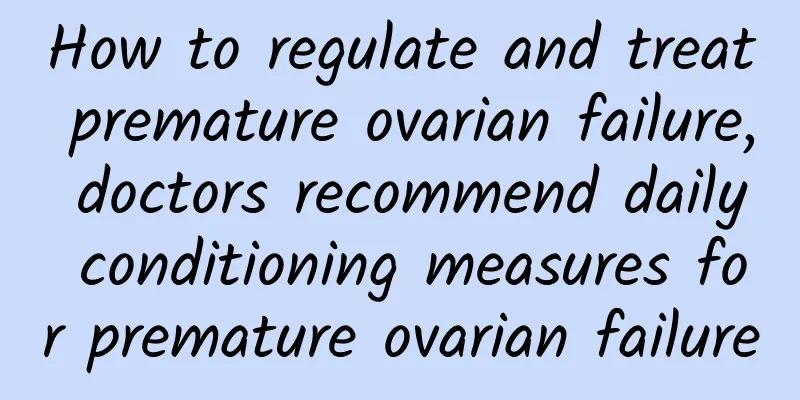Can pelvic peritonitis be cured by taking medicine?

|
The occurrence of pelvic peritonitis is also related to bacterial infection, so everyone needs to understand the occurrence of this disease as early as possible, and must actively treat it. In addition, you must pay attention to your diet and treatment methods to avoid pelvic adhesions and affect your health. So what is the traditional Chinese medicine treatment for pelvic peritonitis? How to use Chinese medicine enema to treat pelvic peritonitis Pelvic peritonitis is a common disease among women and is also a relatively difficult disease to cure. It often occurs during menstruation, after childbirth, after abortion, cesarean section or after gynecological surgery, when bacteria enter the wound and cause infection. Most of the cases of this disease are caused by damp-heat stagnation. The treatment principle is to remove dampness, clear heat and detoxify, and assist with promoting blood circulation and relieving pain. If the lump is obvious, add blood stasis dispersing and knot dispersing products. Drug composition: honeysuckle 15g, forsythia suspensa 15g, patrinia 15g, peach kernel 10g, peony bark 15g, frankincense 8g, myrrh 8g, phellodendron 10g, motherwort 15g, coix seed 30g. For patients with severe damp-heat, add plantain seeds 15g and gardenia 10g; for patients with obvious lumps, add soapberry 15g, Fritillaria thunbergii 15g, three-edged 10g, and zedoaria 10g. Add 500ml of water to the above medicines, soak for 30 minutes, boil into 100ml, pour out, add 300-400ml of water, boil into 100ml, combine the two decoctions, divide into 2 times for enema, retain for more than 2 hours, once a day, 10 times as a course of treatment, stop taking the medicine during menstruation. Take the medicine continuously for 2-3 courses of treatment. Effect of Chinese medicine enema on the treatment of pelvic peritonitis Efficacy criteria: cure: disappearance of symptoms and signs, normal gynecological examination, normal B-ultrasound examination, no recurrence within half a year; improvement: subjective symptoms disappear or are significantly alleviated, gynecological examination shows that uterine and adnexal tenderness is significantly alleviated but still exists, or occasional recurrence within half a year; ineffectiveness: clinical symptoms and signs have not changed much from before treatment. Modern medicine believes that acute pelvic peritonitis is mainly characterized by tissue congestion and edema, adhesion, exudation of inflammatory secretions, infiltration of a large number of inflammatory cells, and even the formation of abscesses; chronic pelvic peritonitis is mainly characterized by tissue adhesion, edema, or varying degrees of congestion. Traditional Chinese medicine does not have the name of "pelvic peritonitis". This disease is scattered in the categories of "menstrual disorders", "metrorrhagia", "dysmenorrhea", "leucorrhea", "infertility", and "vitiligo". The symptoms of acute pelvic peritonitis are summarized as follows: 1. When the disease occurs, there is lower abdominal pain and fever. If the condition is serious, there may be chills, high fever, headache, and loss of appetite. 2. If the disease occurs during menstruation, there may be increased menstrual flow and prolonged menstruation. If the disease occurs outside of menstruation, there may be increased leucorrhea. If there is peritonitis, digestive system symptoms such as nausea, vomiting, abdominal distension, diarrhea, etc. will appear. 3. If an abscess is formed, there may be a lower abdominal mass and local compression and irritation symptoms; if the mass is located in the front, bladder irritation symptoms may occur, such as difficulty urinating and frequent urination. If it causes cystomyositis, there may also be urinary pain. If the mass is located in the back, there may be rectal irritation symptoms. If it is outside the peritoneum, it may cause diarrhea, tenesmus and difficulty defecation. Warm reminder, everyone should understand the occurrence of pelvic peritonitis as early as possible, actively seek treatment, and pay attention to their own hygiene to avoid bacterial infection. Also pay attention to methods of promoting blood circulation and relieving pain to avoid swelling and pain in the body, which will lead to more effects. Everyone should actively seek treatment to avoid causing more trouble. I hope everyone understands the occurrence of the disease as early as possible. |
<<: What medicine is good for pelvic peritonitis
>>: What medicine is used for pelvic peritonitis
Recommend
How to cure chronic pelvic inflammatory disease
Chronic pelvic inflammatory disease (Pelvic infla...
What should be paid attention to when treating cervical erosion? Interpretation of common sense of treatment for female cervical erosion
We talk about many cases of cervical "erosio...
Drinking tea to burn fat and lose excess fat: 3 key points
Most people must have heard about the benefits of...
Eat refrigerator leftovers correctly to prevent liver disease! Nutritionist Wang Zinan: Follow the principle of "four no's and one freshness" to stay away from liver disease
The top ten causes of death in 2022 were announce...
What is the best way to treat vulvar itching?
There is generally no best way to treat vulvar it...
How to delay your period
How to delay menstruation? In special circumstanc...
Treatment of chronic pelvic peritonitis with Chinese patent medicine
Although the symptoms of pelvic peritonitis are n...
Get out of the road to weight loss! 6 special trails recommended by the National Health Administration
Where to go on a hot summer day? Instead of going...
Several major hazards of adnexitis that often occur in life
It is very common for women to suffer from adnexi...
What impact does uterine malformation have on fertility?
The uterus plays an extremely important role in r...
What is the treatment for 3rd degree cervical erosion?
Cervical erosion is a common gynecological diseas...
The secret to losing fat in 2 months: weight training + squats
Those who have been to Japan have probably seen t...
Irregular menstruation is often caused by some diseases
Many women have experienced irregular menstruatio...
Painless abortion surgery examination items
Painless abortion is a type of abortion, which me...
Can patients with chocolate ovarian cysts get pregnant? Does it have any effect?
Chocolate cysts are a type of endometriosis, whic...









